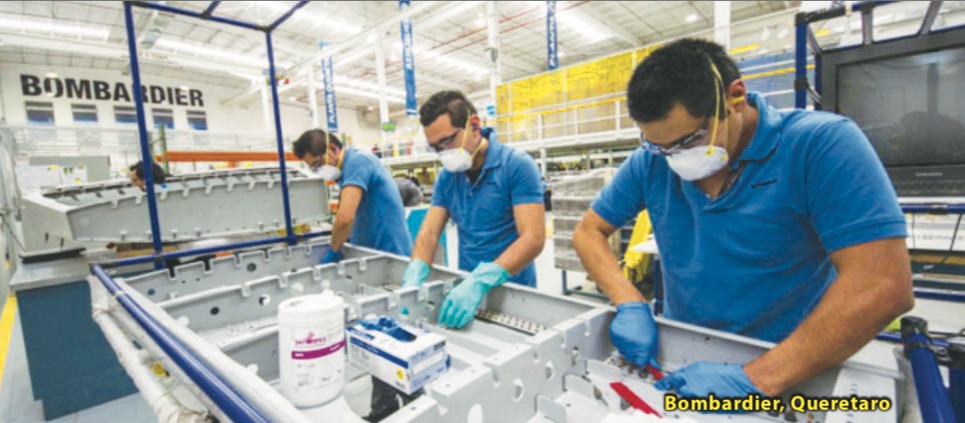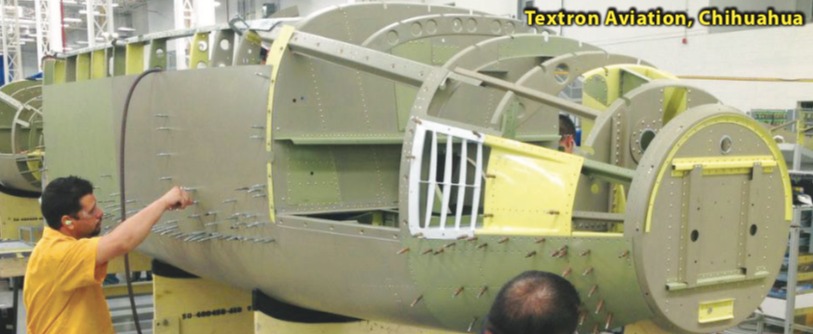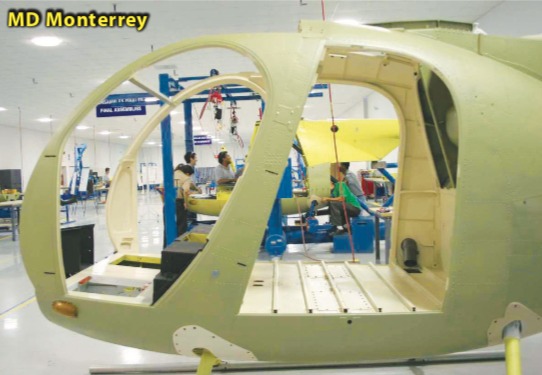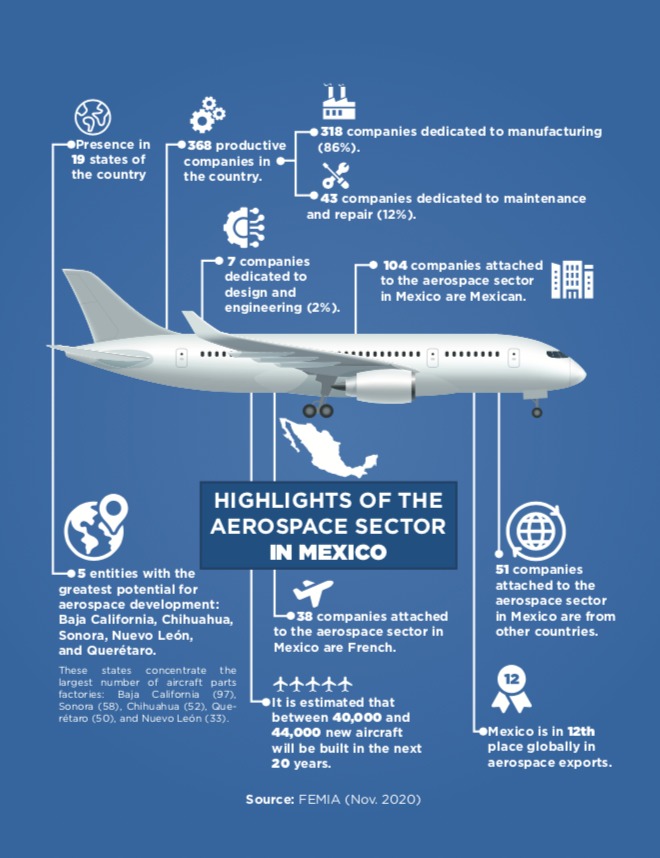Aerospace Clusters: Time for Collaboration

Warning: foreach() argument must be of type array|object, bool given in /home/mexiconow/public_html/sites/mexiconow/wp-content/themes/mexiconowwpnew/single.php on line 176
By Iván Iglesias
Aerospace clusters are among the most dynamic in the manufacturing industry and they continue to grow in Mexico. More than 300 companies in Mexico belong to the aerospace industry, which are located in Baja California, Sonora, Chihuahua, Coahuila, Nuevo León, State of Mexico, CDMX, Guanajuato, Jalisco, Puebla, Aguascalientes, San Luís Potosí, Tamaulipas, Yucatán, Zacatecas, and Querétaro.
Each cluster is clear about its initiatives, but current times are impacting their local needs, so “there are challenges that are shared between clusters,” said René Espinosa, president of FEMIA, in an interview. Faced with such a situation, strategic actions are currently being envisaged that involve many aerospace clusters. Among these, collaboration has become a priority factor.
For example, through an alliance between the Central-Bajío-West clusters, the integration of the country’s first aerospace, aeronautical and defense cluster is already emerging. The director of the Querétaro Aero cluster, Antonio Velázquez Solís, explained that this project seeks to create synergy between the industry of the region. “In the past there were times of great competition. Today collaboration will be a fundamental piece, an instrument for the development of the sector and to have a stronger and more competitive industry,” he said.
The five entities that make up the alliance are home to 68 companies: 50 in Querétaro, 10 in Jalisco, five in Guanajuato, two in San Luis Potosí and one in Aguascalientes, according to information from FEMIA. This conglomerate of companies represents 18.5% of the 368 accounted for.
Regarding collaboration schemes, René Espinosa affirms that in recent years many links have developed, including with international clusters. “There are European clusters that share many challenges with us, so very close working ties have been developed. For example, when I was president of the Chihuahua Cluster, I had the opportunity to collaborate with the network of European clusters and with those of Querétaro and Monterrey. For this reason, I think it is essential that the clusters continue to share their capacities because it is the ideal benchmarking opportunity for everyone to continue advancing in their development.”
These examples of collaboration schemes are already a priority in the strategies of some of the most prominent clusters of the Mexican aerospace industry. Let’s look at them:
The Querétaro Aerospace Cluster
During the pandemic, passenger traffic came to a halt, and, with less use of aircraft, there was less need for maintenance and increased order cancellations for new aircraft. This domino effect has produced a reconfiguration in the air value chain. “Recovery will take more than three years in the most conservative scenario, but we have reports that it could take up to 10 years,” said Antonio Velázquez, general director of the Querétaro aerospace cluster.
Even with this outlook, there are opportunities for the future: Since 2020, according to Velázquez, the Querétaro aerospace cluster has formed a strategic analysis group to collaborate with smalland medium-sized companies and start ups that promote aerospace technology, without neglecting big companies. This year an Aerospace Industry Recovery Plan will be implemented in the state, which includes several points: 1) Diversification, to expand into the defense and space areas; 2) greater regional integration, to strengthen the diversification of companies that are in other sectors and develop suppliers; 3) talent support; 4) dissemination of capacities of national aeronautical companies in regional and international forums, among others. These actions are strategically supported by the theme of diversification. “This year or the next, aeronautical companies will look to Mexico to locate and strengthen the supply chain at the national level,” said Velázquez.
The Querétaro Aerospace Cluster currently integrates 70 members and associates, represents 12,000 people employed in the sector and operations that account for US$1.2 million.
The Chihuahua Aerospace Cluster
With 25% of the country’s aerospace plants, Chihuahua is a firm representative of the national aerospace industry, since the capital is among the first 10 cities in terms of attracting investment in the field, according to the British newspaper Financial Times.
“Future times look positive, although recovering the levels of 2019 will happen until 2024,” said Adolfo Viramontes, president of the Chihuahua aerospace cluster. “We have a strong cluster; in fact, we have seen an increase in our number of associates from 2019 to date. Our associates understand the need to do business and to be united to face the crisis.”
Among the great objectives of the Chihuahua cluster is to continue supporting small- and medium-sized businesses. “How are we helping? Firstly, being together as members, which makes the cluster more solid in support and promotion during events, as will happen in the next FAMEX.” Additionally, Viramontes sees a strong supply in the state: “There is an opportunity in Mexico to continue providing high-level supply internationally. And, as leaders, we have the responsibility to promote our country, because there is quality, talent and leadership to offer to other countries.”

The Baja California Aerospace Cluster
The Baja California Aerospace Cluster is also among the giants of the Mexican aerospace sector; the state is home to research and manufacturing facilities for 59 international companies. Its average annual growth of more than 20% in the last 10 years also confirms its leadership. In particular, Tomás Sibaja, president of the cluster, sees a future with resilient visions and an economic rebound: “Similar to other pandemics that have occurred in the world, the industry is affected in the short term in the matter of its manufacturing, but the recovery is always promising in the long term. (…) So far, the sector has been resilient, and the forecasts are positive; we are definitely an industry that is going to rise up soon. For example, Baja California serves defense projects in the United States, and being this a strategic sector for them, we managed not to stop our plants to continue serving that sector. This was a very good thing, so much so that during the pandemic our unemployment level was only at 2% (…). Likewise, we are strongly experiencing the regionalization of American companies, since much of what used to be manufactured in China is now being done in Mexico.”
Given the circumstances, interaction is essential for Sibaja. “We have understood that no one can work in isolation. In the way we cooperate, contribute, and engage in our area of expertise, other parties have to do the same. Cooperation opens bridges of understanding and areas of inclusion.”

The Nuevo León Aerospace Cluster
The Monterrey Aero Cluster, created in 2009 with the objective of promoting regional integration for the development of the aerospace sector in the state, also advances its predictions cautiously. “For this year, the forecast is conservative for the aerospace industry. There is still uncertainty in our sector,” said Claire Barnouin, executive director of the cluster. Regarding the postpandemic growth prospects, “I think they are good, especially since this crisis also brought the opportunity to grow by consolidating value chains.” Thus, the strategies in the supply chains are drastically changing “and tend towards a much stronger regionalization and, even, towards the migration of production lines from the United States to Mexico,” said Barnouin.

The Sonora Aerospace Cluster
There are currently 69 companies in Sonora’s aerospace sector and, as a whole, the industry employs more than 20,000 people, thus being among the entities that attract the most investment. The director of the Maquiladora Export Industry (Index) of Nogales, Genaro Vecerra Álvarez, says that aerospace companies represent future job growth in Sonora and that a promising future is projected for this sector. Among the factors that have influenced the growth of this industry are the proximity to the United States, the educational infrastructure, and the skilled workforce. “Sonora is among the first three states in the country that joined the aerospace industry and is number one due to its proximity to the border, the level of its schools and the openness of the state government, given that only in the last three years three aerospace companies have been opened in our entity, so we see a near future of even greater growth.”
The younger clusters
There are also recently created clusters that seek to strategically cement supply, engineering and talent operations, as well as the development of investments in each region. Among these are the clusters of Sinaloa and Baja California Sur, who agree in their vision of working for the common good to achieve the momentum of their respective states and the national economy.
Eduardo Guízar, president of the Sinaloa cluster, affirms that this industry is growing more and more. “This growth has been around for a long time, but it has accelerated in an unexpected way. The world continues with a great demand for aircraft, and Mexico is not far behind; we are part of the ‘race.’ Therefore, we must make an alliance with educational institutions and, of course, with the government to strengthen the triple helix. The keywords are persistence and resilience because slow times will come, but we must always keep an eye on more positive and fluid times that are also coming. That’s what we bet on. Equally, alliances are important: the birth of this cluster would have been much more difficult without the support of the Baja California cluster. [Unity is strength.] If we were working separately, things would fall apart, we could not grow as a country.”
For his part, Daniel Salorio, president of the Baja California Sur aerospace cluster, said that after an economic crisis there is always a rebound. “In the aerospace area, in particular, there is greater demand for new aircraft, so there is growth because it is necessary to increase production levels.” In turn, this cluster is forming an alliance with other clusters “to promote the arrival of companies that come to invest in the state,” said Salorio. For this reason, we seek to share knowledge so that the industry continues to grow in the future. We are open to receiving proposals from other companies and clusters to continue nurturing the regional ecosystem.”
A future together
As can be seen, the joint vision of the main aerospace clusters in the country points to future shared strategies. According to its main representatives, the times of working alone are over. Today, collaboration sets the stage for greater competitiveness.
René Espinosa, president of FEMIA, is clear: “[We must] continue listening to the needs of the academic, labor and industrial aspects of what each region needs. Years ago, the regions fought to have everything, but in recent years we have been able to see how each region outlines a shared organic vocation, and each one of the clusters is growing and taking advantage of new opportunities thanks to it.”






